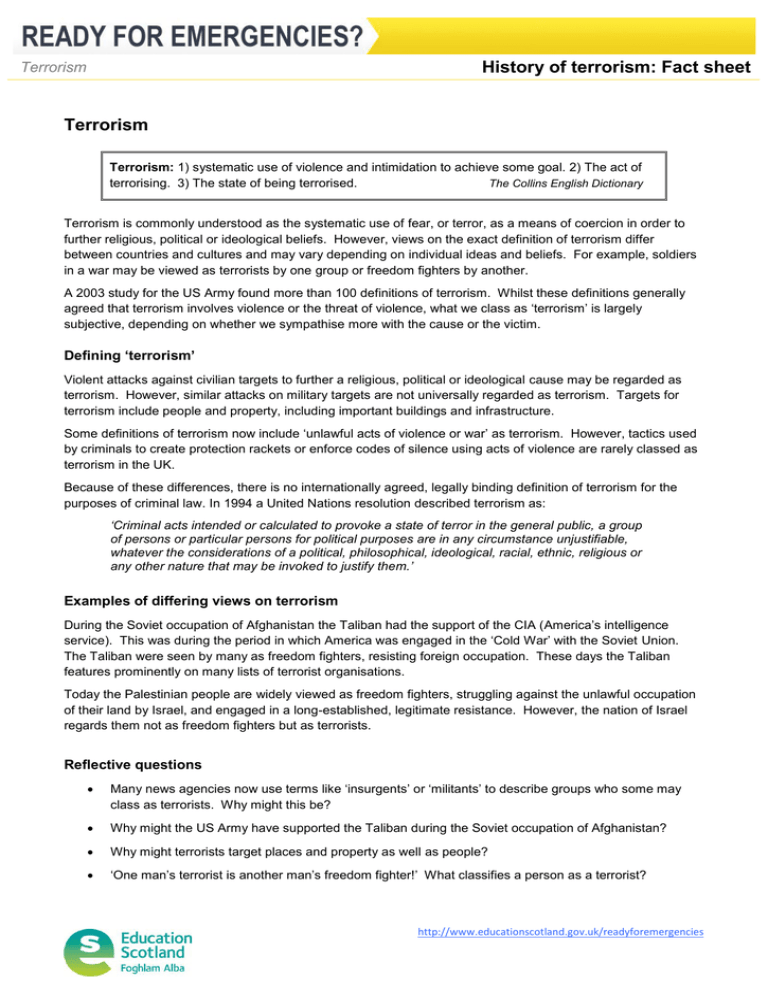History of terrorism: Fact sheet Terrorism
advertisement

History of terrorism: Fact sheet Terrorism Terrorism Terrorism: 1) systematic use of violence and intimidation to achieve some goal. 2) The act of terrorising. 3) The state of being terrorised. The Collins English Dictionary Terrorism is commonly understood as the systematic use of fear, or terror, as a means of coercion in order to further religious, political or ideological beliefs. However, views on the exact definition of terrorism differ between countries and cultures and may vary depending on individual ideas and beliefs. For example, soldiers in a war may be viewed as terrorists by one group or freedom fighters by another. A 2003 study for the US Army found more than 100 definitions of terrorism. Whilst these definitions generally agreed that terrorism involves violence or the threat of violence, what we class as ‘terrorism’ is largely subjective, depending on whether we sympathise more with the cause or the victim. Defining ‘terrorism’ Violent attacks against civilian targets to further a religious, political or ideological cause may be regarded as terrorism. However, similar attacks on military targets are not universally regarded as terrorism. Targets for terrorism include people and property, including important buildings and infrastructure. Some definitions of terrorism now include ‘unlawful acts of violence or war’ as terrorism. However, tactics used by criminals to create protection rackets or enforce codes of silence using acts of violence are rarely classed as terrorism in the UK. Because of these differences, there is no internationally agreed, legally binding definition of terrorism for the purposes of criminal law. In 1994 a United Nations resolution described terrorism as: ‘Criminal acts intended or calculated to provoke a state of terror in the general public, a group of persons or particular persons for political purposes are in any circumstance unjustifiable, whatever the considerations of a political, philosophical, ideological, racial, ethnic, religious or any other nature that may be invoked to justify them.’ Examples of differing views on terrorism During the Soviet occupation of Afghanistan the Taliban had the support of the CIA (America’s intelligence service). This was during the period in which America was engaged in the ‘Cold War’ with the Soviet Union. The Taliban were seen by many as freedom fighters, resisting foreign occupation. These days the Taliban features prominently on many lists of terrorist organisations. Today the Palestinian people are widely viewed as freedom fighters, struggling against the unlawful occupation of their land by Israel, and engaged in a long-established, legitimate resistance. However, the nation of Israel regards them not as freedom fighters but as terrorists. Reflective questions Many news agencies now use terms like ‘insurgents’ or ‘militants’ to describe groups who some may class as terrorists. Why might this be? Why might the US Army have supported the Taliban during the Soviet occupation of Afghanistan? Why might terrorists target places and property as well as people? ‘One man’s terrorist is another man’s freedom fighter!’ What classifies a person as a terrorist? http://www.educationscotland.gov.uk/readyforemergencies




